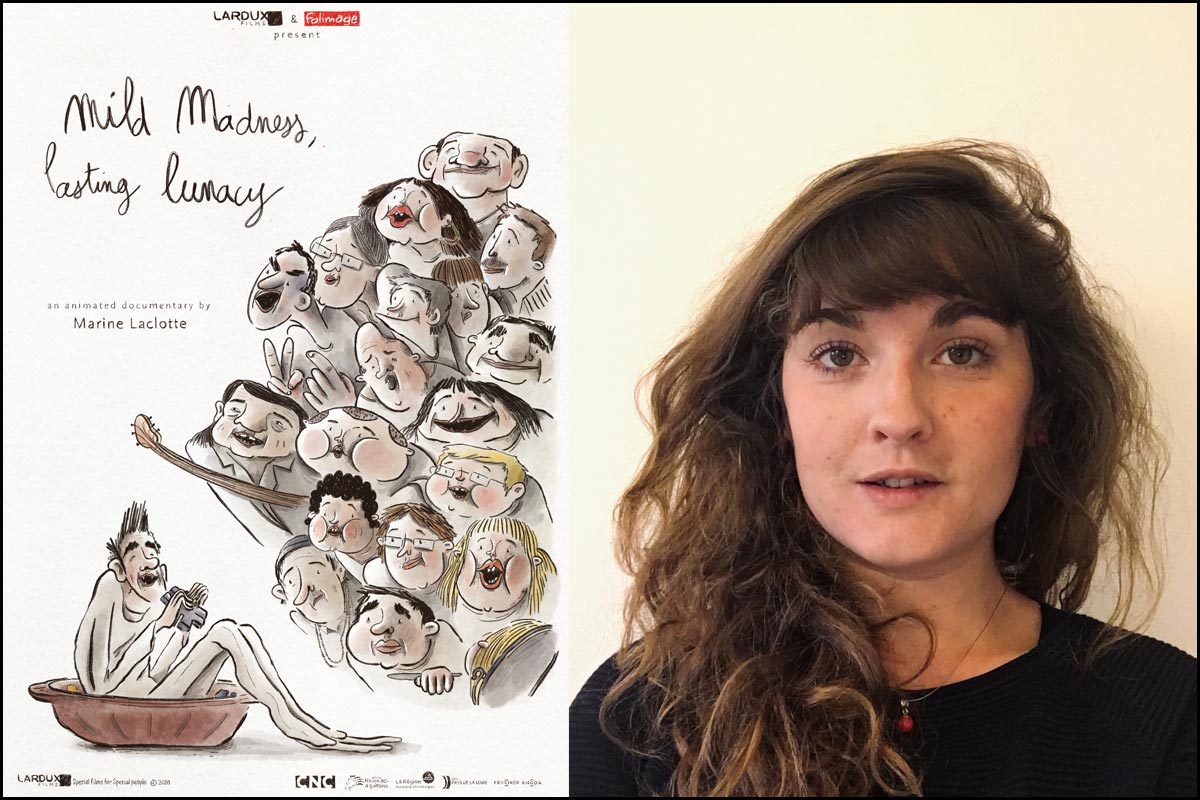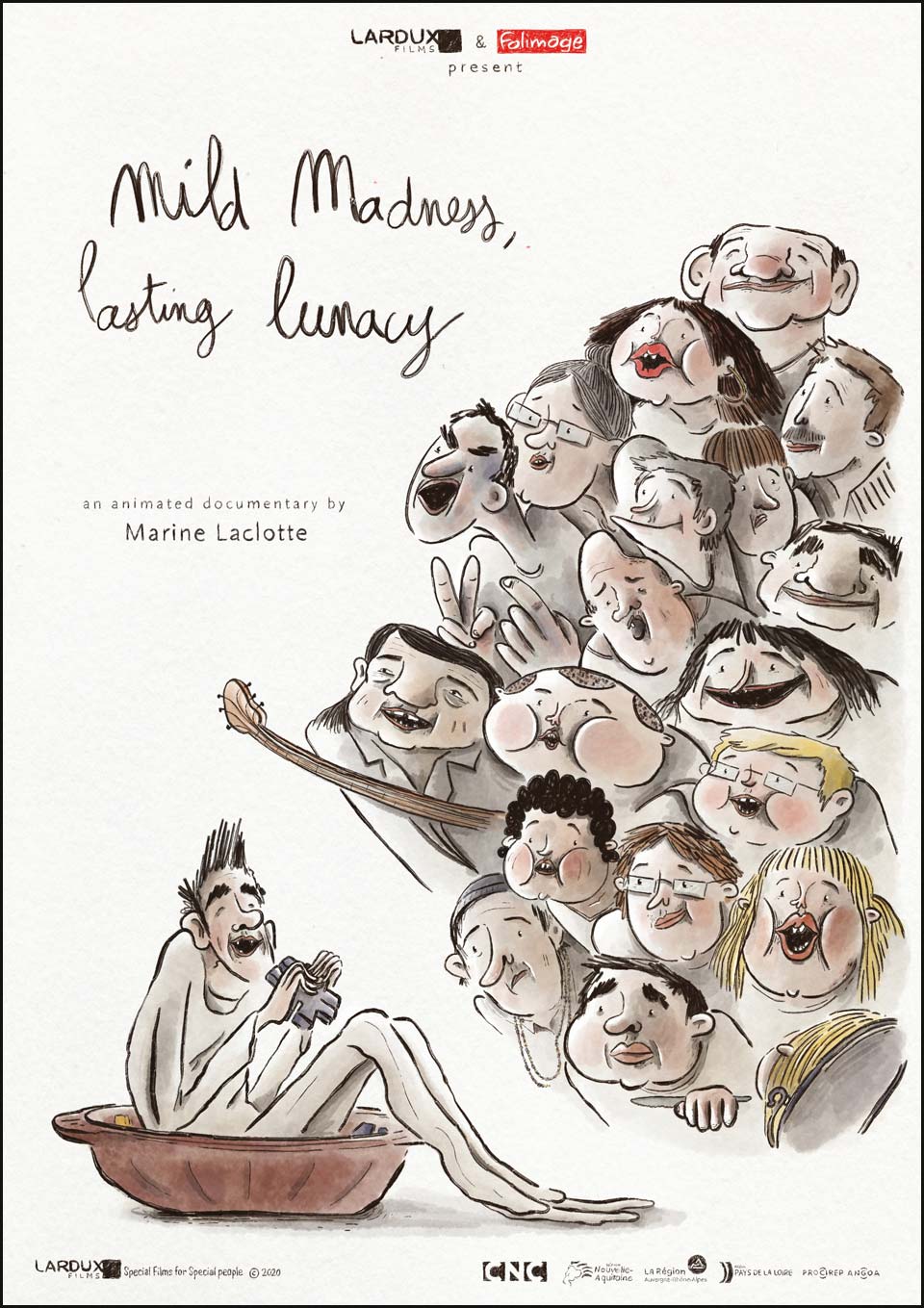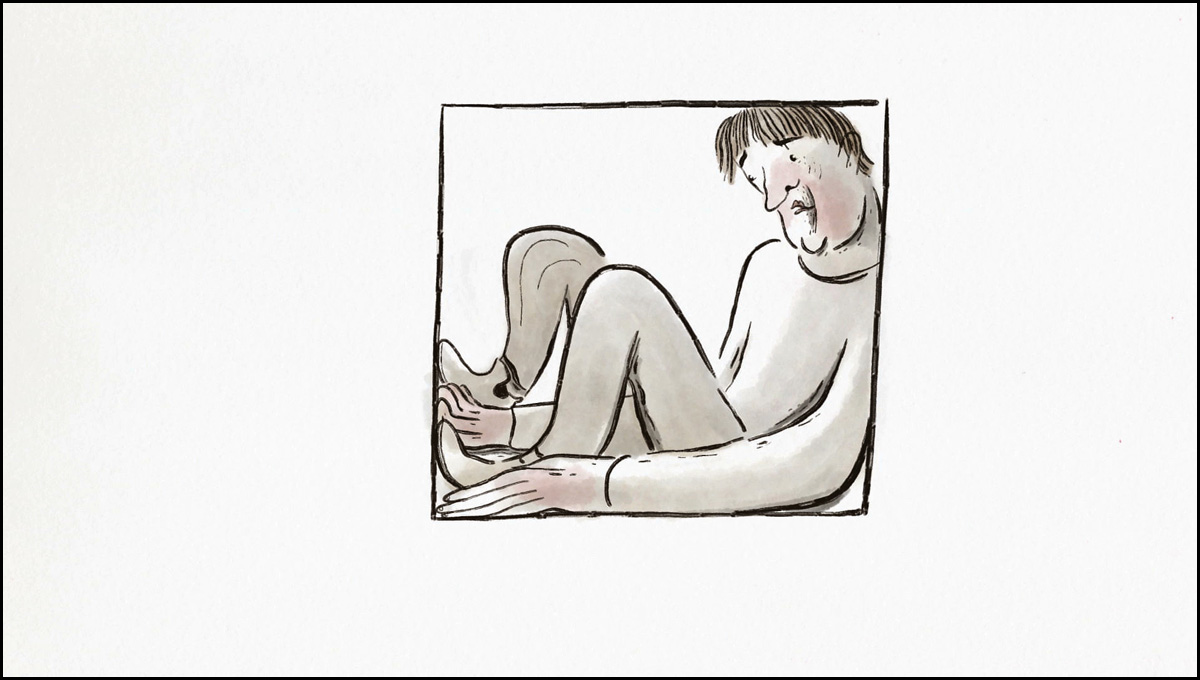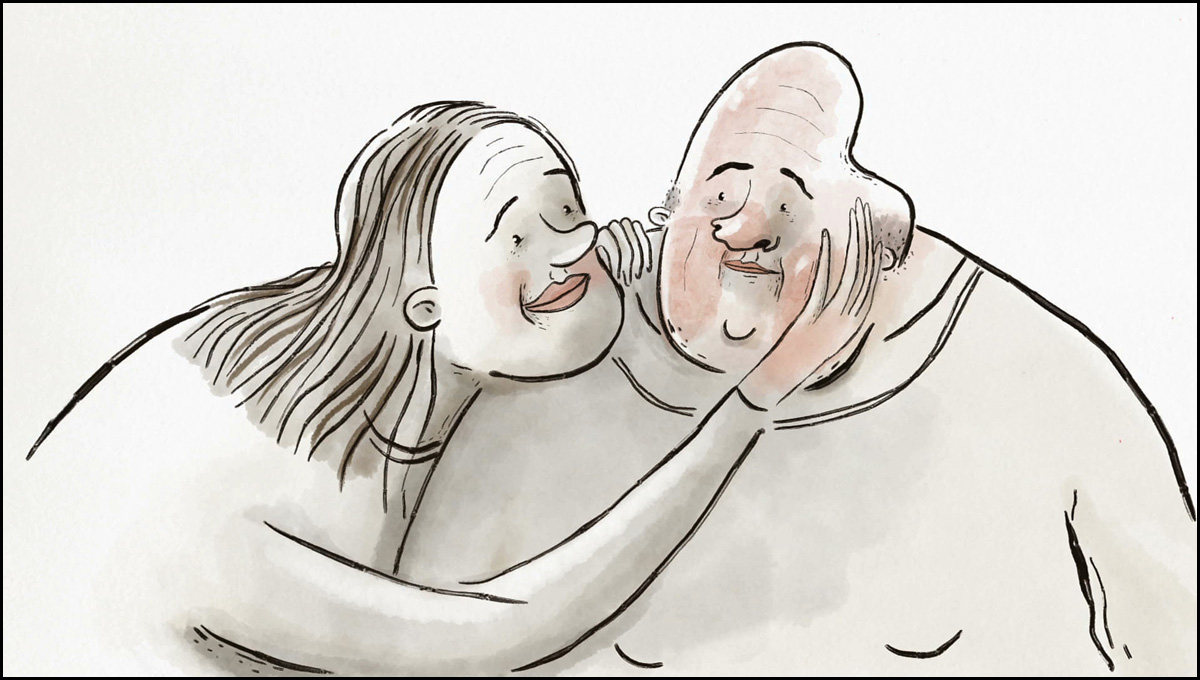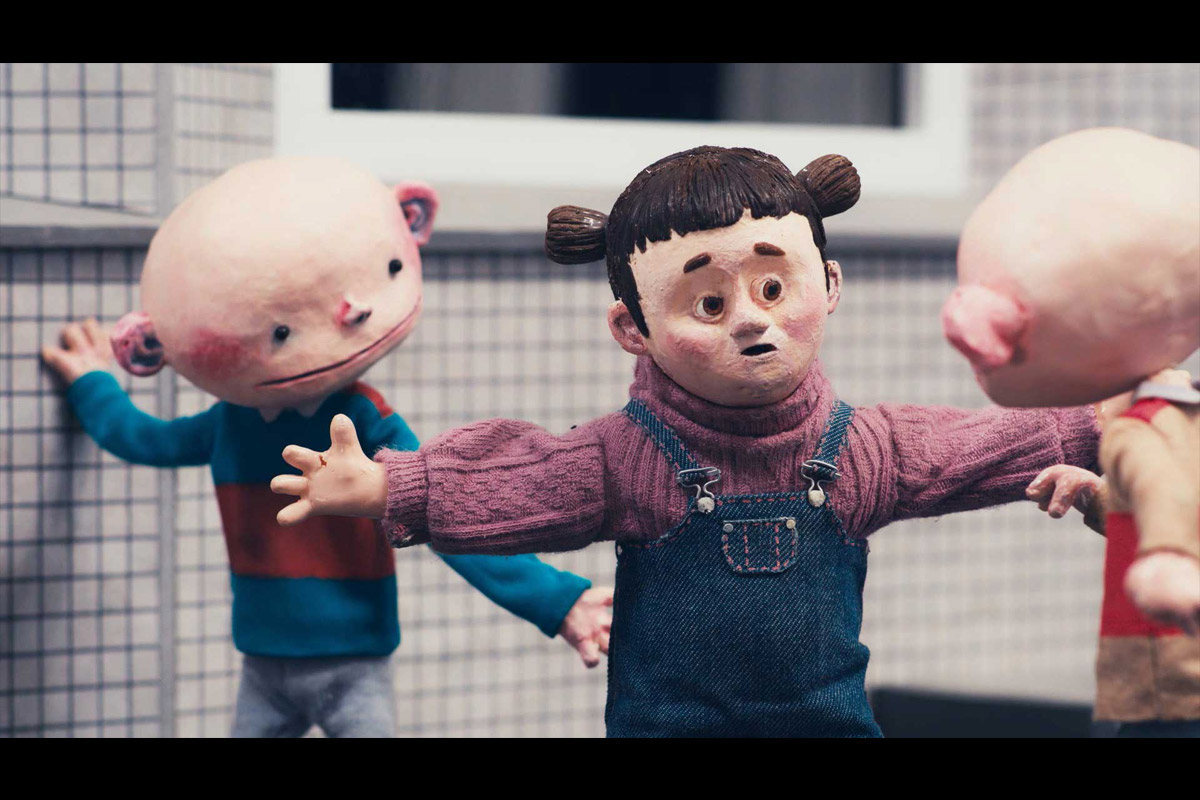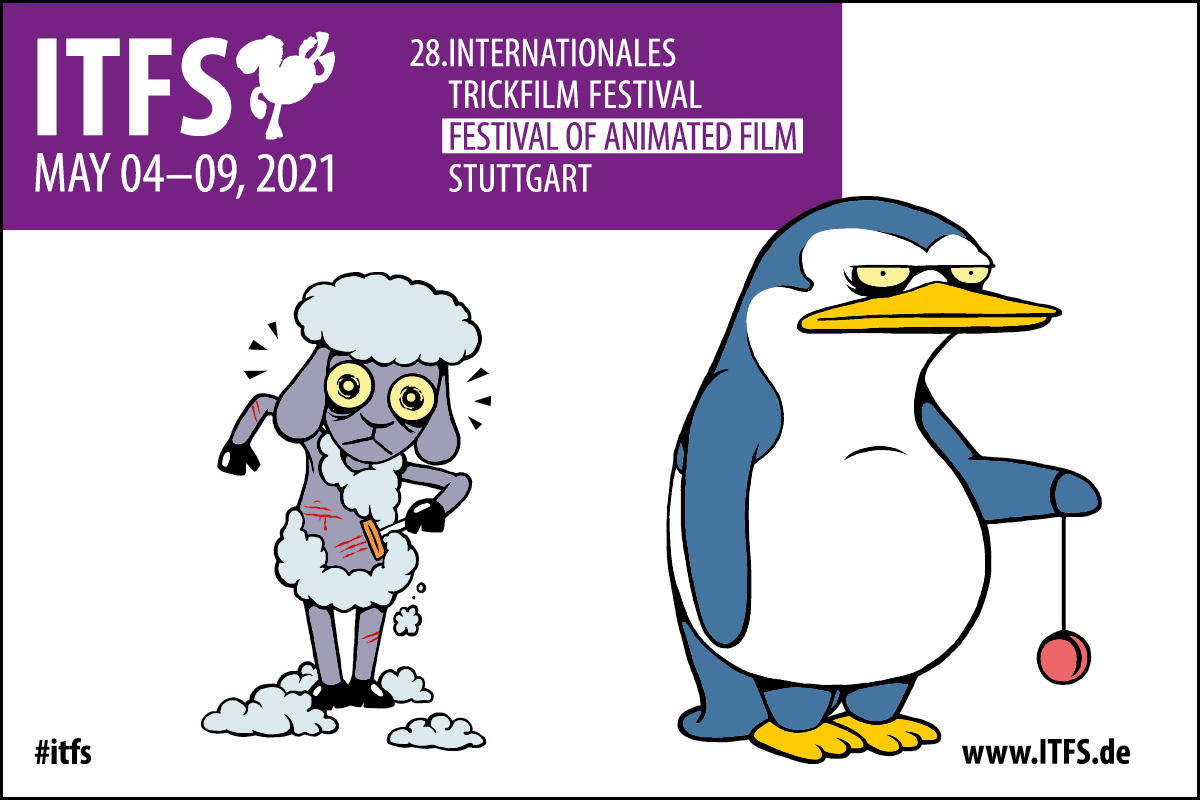Mild Madness, Lasting Lunacy
Synopsis
This walk in the daily life of several psychiatric institutions, allows us to meet extraordinary people who let us enter their privacy.
Mild Madness, Lasting Lunacy
(Original French title: Folie douce, folie dure)
Director: Marine Laclotte
Author: Marine Laclotte
Producers: Christian Pfohl (Lardux Films), Corinne Destombes (Folimage), Pierre Meloni (Folimage) and Reginald de Guillebon (Folimage)
Sound: Camille Erder, Flavien Van Azefeld and Adam Wolny
Editors: Thomas Grandremy, Claude Clorennec and Catherine Aladenise
Production: Folimage
Mild Madness, Lasting Lunacy is a short film that delicately deals with a difficult topic by utilising the strength of animation to visualize the creators’ experience with patients in psychiatric institutions through her interviews and observations. It is an enlightening animated documentary that illuminates the personality in each patient. The film was nominated for the “International Competition” category at the 28th Stuttgart International Festival of Animated Film (ITFS).
Through simple visual designs and compositions which do not interfere audience’s quiet engagement with the patients, accompanied by fluid and smooth camerawork, the film gives you the experience to step into the patients’ individual worlds and be with them in their most sincere moments.
We heard the insightful story behind the film from Marine Laclotte, the director and author of the film.
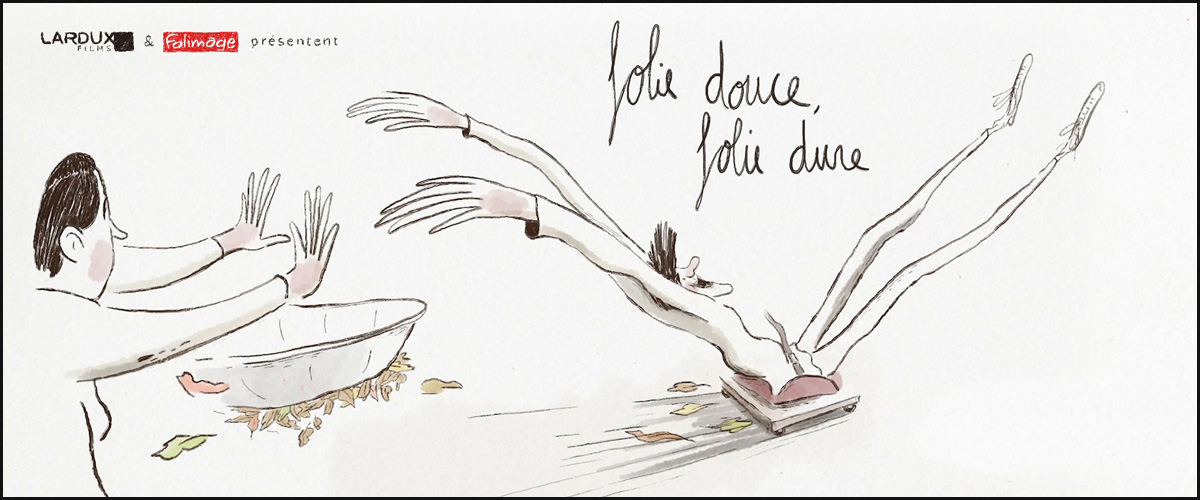
Interview with Marine Laclotte
Hideki Nagaishi (HN): Could you let us know what kind of message or experience you want to deliver to the audience the most through the film?
Marine Laclotte: I wanted to show another image of people in psychiatric institutions than the one we have that arrived from spontaneity, those preconceived ideas usually conveyed by the media. I wanted to bring the audience beyond the fear of the other, so they can feel and meet the humanness of the characters.
HN: What was the reason to develop a film about a psychiatric institution?
Marine Laclotte: I didn’t want to make a film about a psychiatric institute, but more about the people I met in this type of place who have touched and moved me.
Besides, there are several locations in the film. Not everything takes place in the same hospital, but I didn’t want to explain that. What mattered was to share the human things.
I chose 5 shooting locations, including 2 long-term care units belonging to the same hospital (one for young people and the other for older people with heavier motor problems). Then another institution more open, for young people in “post-crisis” and a group of mutual self-care managed by people in difficulties, totally opened, a place in which people share daily moments to develop social ties.
But the true reason behind developing that project was my own story. I grew up in a city that is home to a large psychiatric hospital, where my mother works. I met strange and different people every day since childhood and I learned to look at them differently than strangers, thanks to my mother’s very benevolent look. This is what I wanted to share with this film.
HN: Could we hear briefly about your journey to develop this insightful film by a deep observation of psychiatric patients?
Marine Laclotte: What I like about the idea of shooting a documentary is to get on the set with very little information in order to be more spontaneous and sincere. After having met the heads of the various institutions and units, my sound recordist friend, Camille, and I, blended ourselves into the daily life of these places, at first without microphones, with time to get to know the people in care and the caregivers. We asked very few medical questions. We shared the workshops, the meals, the daily life, trying to meet the others, to exchange and share things.
At the beginning, I didn’t want to include any medical discourse in the film but simply let the people in care speak.
But during the shooting, some gestures or situations questioned us too much to remain without explanations. With the help of the speech nurses, we were able to better understand and know the people. It was at this point that I decided to include some explanations from the nurses in the film, because I understood that explanation allowed empathy. Violent gestures, for example, became understandable and it seemed important to me to give the viewer access to these explanations to allow the connection.
HN: Do the all the patients you met through your interview appear in the film? If not, how did you select patients to depict in the film?
Marine Laclotte: No, they are far from being all present. To choose which scenes to keep in the film was very hard. I was guided by an editor and documentary film-maker to build bridges between the scenes and to keep those which answer to each other without repetition.
I had 49 hours of sound footage in my suitcases and I wanted to make a short film not exceeding 20 minutes.
We came up with a 20-minute sound montage in the development phase, which I kept editing during the creation of the animatic.
The image and the sound complementing each other, I constantly needed to go back to the rushes to pick back scenes we had left and, over time, remove others that seemed less evocative in retrospect.
I gave myself the freedom to modify the editing until the very last minute of the fabrication, I think it reassured me to know that everything was still possible.
But I still have a lot of recordings that could have been used in the film. Unfortunately, I had to choose. I keep them for me, they are my memories.

HN: The film animates the psychiatric patients’ emotions delicately and sensitively, and it was very impressive. I could get the individuality of psychiatric patients clearly and have strong sympathy with their emotions. I’m curious about how you achieved to animate them so lively. Could you let us know the process of the visual development for the film?
Marine Laclotte: I think the animation is lively simply because the film features real, lively people. Every scene in the film is a moment that I really lived and shared. During shooting I chose not to take any pictures to be able to live in the moment. I was deeply moved by these people, these are emotions that I felt in my stomach and I wouldn’t have been able to bring them out in live action for example. I also spent time observing, gestures, faces, listening, and deciphering the requests. Thanks to the caregivers, I was able to learn to understand the particular language of certain people who did not express themselves with sentences, but with sounds or signs.
When I was drawing and animating, thanks to the sound, I was able to relive and feel again everything that had gone through me during the shooting. This is what allowed me to be accurate.
For the direction, the memory was stronger than the photo. I called upon my memory. Some shots were animated 4 years after the sound shoot and I remembered this moment as if I had just lived it, thanks to the power of sound.
HN: What did you take care the most when you designed the characters’ visuals, developed the storyboard and directing the animation?
Marine Laclotte: What was most important to me was to respect the people I was portraying. During my first research, before shooting the sound, I had developed a more particular, more personal graphic style. But once I had actually met the people in the film, I was no longer able to stylize my line, I needed to stay close to their real bodies and expressions. Even though the film has a graphic identity, I feel like I stayed very wise in my line. So I expressed myself more by my direction than by the drawing of the characters.
I made the storyboard directly in digital in my animation software, going with the flow of the sound. I couldn’t board without feeling the timing of the sound.
My animatics was very advanced, I had almost drawn all the key animation poses in rough. I couldn’t do anything more synthetical because I had a lot of sound information and the sound was very spatial in the tracks. When a scream came from the side or the back, you could feel it in the sound, that’s also what led to my direction.
When I gave the scenes to the female animators, everything was already set and it was very simple for them to get into the shots and to get to know the people with my roughs and the sound.
HN: The camera zooms into the characters and only some key items around them are drawn in the background throughout the film. And the background arts have many white spaces and leave out detailed visual description. Could you please let us know your intention of this?
Marine Laclotte: This is also due to working with memories. The memory does not keep what is useless. At the time of the shooting, I was paying attention to what we were recording. At the time of adapting that into pictures, which is also what I did, the background seemed useless to me if it was only a decor. In my film, the background is the sound. It occupies so much space that I didn’t need to show too much. Also I wanted the camera to be mobile as we had been on location with the boom, so it was easier to draw only what serves the scene. I think this way of doing things was also able to leave room for the viewer to imagine things as well.
HN: Could you please share the reason why you titled this film Folie douce, folie dure (English title: Mild Madness, Lasting Lunacy)?
Marine Laclotte: My mother came up with the title when I was writing the intentions for the film, before the shooting. It was a way to name the ambivalence of things. I knew that in spite of the harshness of the diseases, I was also going to encounter a lot of gentleness, humor and poetry. I also think that we all carry sweet madness. In the film, the caregivers also bring it to everyday life, through play and laughter. It was a title that seemed to me quite appropriate for what I wanted to show with this film.


